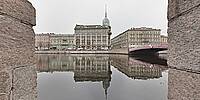
Stability
The Moyka river, Saint Petersburg, Russian Federation
November 2, 2021 - 7:04 GMT
© 2021 Andrew Varlamov, All Rights Reserved.
Wind is trying to get out autumn fog and to ruffle reflection on water surface of the Moyka river.
Lat: 59° 55' 57.766" N
Long: 30° 18' 54.008" E
Precision is: Medium. Nearby, but not to the last decimal.
Camera: Pentax K-5 II; Lenses: smc PENTAX-DA Fish-Eye 1:3.5-4.5 10-17mm ED (IF); Tripod: Manfrotto 190XB; Panohead: Nodal Ninja 5; PC Software: PTGui Pro 12.7 by New House Internet Services B.V. (dated by June 22, 2021), Pano2VR 6.1.8 pro 64bit by Garden Gnome Software (dated by May 25, 2020)
(This is direct citation from https://aupontrouge.ru/en/history/ )
Purchase of the Land
The history of the building of the Au Pont Rouge department store ("At the Red Bridge") in its modern form begins in 1905, when the representatives of the board of the famous Belgian-Dutch trading firm "S.Esders and K.Scheefhals", the world supplier of ready-made women's and men's dresses, bought plot of land and a corner house on the embankment of the Moyka River, 73, and Gorokhovaya Street, 15.
In the same year, the Belgian-Austrian entrepreneur Stefan Esders and his partner and nephew Karl/Charles Scheefhals of the Netherlands applied for permission to build a five-story building with an attic for a modern trading house.
Permission was received, and in the period 1906-1907 at the Red Bridge under the project of St. Petersburg architects Vladimir Alexandrovich Lipsky and Konstantin Nikolaevich de Rochefort erected an unusual structure of the trading house "S.Esders and K.Scheefhals."
Construction of the Building, Features of Decoration
The basis of the art nouveau building was a massive metal frame weighing 70,000 poods (1,147 tons), the idea of which Rochefort borrowed from the recently opened building of the company "Singer" on Nevsky Prospekt, an original example of a combination of Paris and New York styles.
However, the building on the Moika is more modest, all the magnificent details are moved upward. The bottom of the house is something in tune with modern architecture, huge rectangular windows and rather narrow piers. On the fourth floor - window openings with a semicircular completion, on the fifth - double windows, and the attic floor was decorated with windows of a horseshoe shape.
Water lilies are depicted over the windows of the fourth floor, on the piers - garlands descending from the medallions. The facade from the side of the Moika River ends with a low attic with the names of the owners.
The original cut off corner of the house creates the impression of a smooth transition from Gorokhovaya Street to the embankment of the Moika River. The corner of the house was originally crowned by a tall spire [1], which bedecked the Trading House "At the Red Bridge".
After completion of works, the acceptance authority committee noted that the building of a commercial enterprise on the corner plot No. 73/15 of the right bank of the Moika and Gorokhovaya Street fully complies with the modern requirements of a large shopping center.
First Multistage Shop in Russia
With its design and convenient placement of shopping and showrooms, storage and office premises, the building fully complied with the standards of the best European department stores of the early 20th century.
At the same time, the building became the first multi-storey store in Russia.
For ten years, until 1917, the Trading House on the Moika was considered the most fashionable and rich trading enterprise, offering comfortable conditions and a wide range of goods for wealthy buyers of St. Petersburg. It was a chic, spacious, light-flooded grand magasin, where everything was sold, from lace and gloves to cloaks and hats.
Among the customers of the store were members of the imperial family, including the Empress Alexandra Feodorovna, the wife of Nicholas II.
Sewing Factory
After the October Revolution, the building abandoned by the owners was empty for a year and a half until in July 1919 the Council of the National Economy of the Northern District of Petrograd passed a decision to transfer the building of the store to the Central Garment Factory. In 1922, this Leningrad production was given the name of the Soviet commissar V. Volodarsky, who was a tailor before the revolution.
In September 1928, the shop sewing ladies' clothing of the factory named in honor of Volodarsky was assigned to an independent factory "Bolshevichka", which became one of the most famous Soviet consumer goods industry enterprises.
In 1992, the enterprise was reorganized into CJSC "Clothes Factory of St.Petersburg" (trade mark FOSP).
The Building during the Soviet Period
In 1930s the steeple of the building was destroyed and several versions of this action appeared. The first runs that many Leningrad buildings of the Art Nouveau and Eclectic periods were deprived of their steeples. The last prevented the transmission of the television signal. According to another version, frequent leaking became the reason of the removal. Moreover, the steeple could have been destroyed to improve the Gorokhovaya Street and Admiralty building appearance.
As well, in 1960s the glass dome (roof lantern) was taken apart.
It stands to mention, that the buildings of “Esders & Sheyfals” company were also situated in Wroclaw, Vienna, Brussels and Paris, however, only Saint-Petersburg and Paris buildings have remained up to this day. The last serves as C&A department store.
Reconstruction of the Building
In 2009-2014 the building was reconstructed by “BTK Development”. In particular, the following elements were restored: the tower with the steeple in the form of caduceus (staff carried by Mercurius, the patron of commerce); golden inscriptions in French and Russian (the spelling is preserved in pre-reform, prerevolutionary writing - for example, "Tuzhurki"); and the attic with the owners’ names.
None of the exact drawing of the steeple is preserved, so it has been recreated after the drafts and photographs. However, the size of it is exactly the same as it was in the original - 29 meters in height.
The building is an architectural monument of federal significance and it is included in the UNESCO world heritage site "Historic Center of Saint-Petersburg".


 Tap or click the zoom icon in the bottom right corner of the picture to switch between in-page and fullscreen view
Tap or click the zoom icon in the bottom right corner of the picture to switch between in-page and fullscreen view